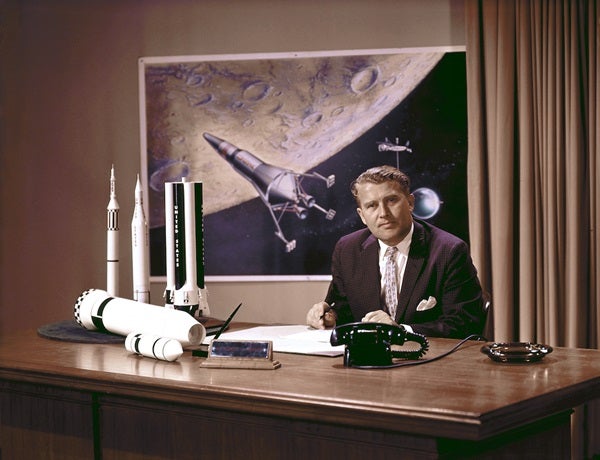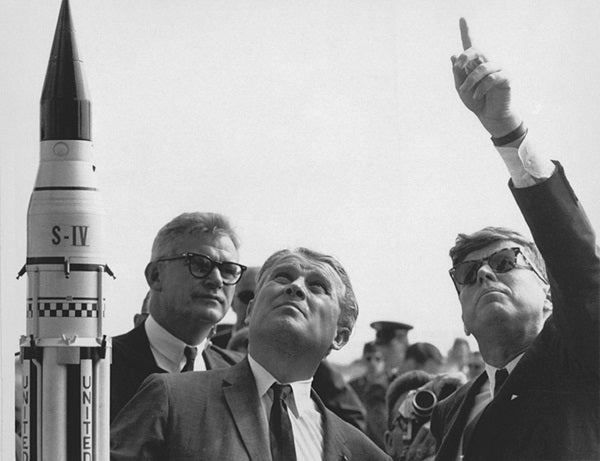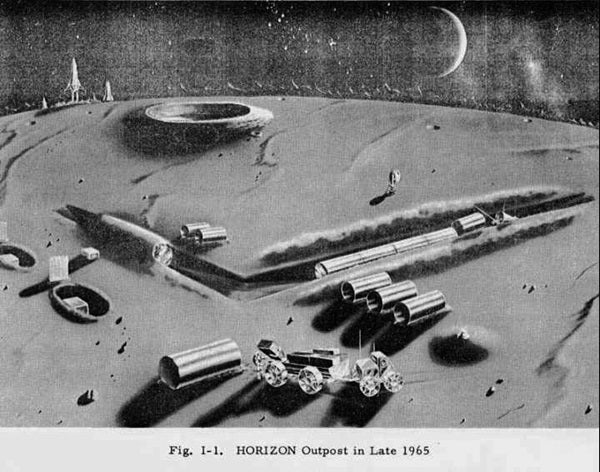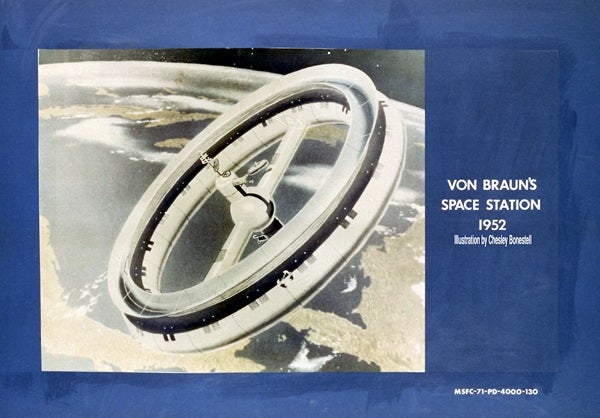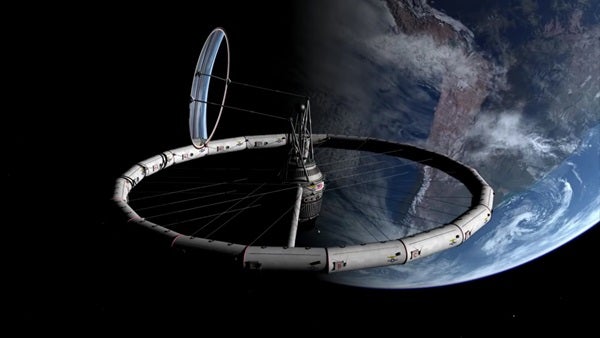But space has never been a benign environment — and not just because of the bug-eyed monsters imagined by early science fiction writers. While robotic rovers on Mars symbolize our thirst for scientific knowledge and the International Space Station exemplifies international cooperation, peaceful and purely scientific pursuits in outer space have always contended with militaristic ambitions. And no one better embodied the tension between militarism and the high ideals of spaceflight than Wernher von Braun.
From V-2s to space stations
As a teenager in the 1920s, von Braun was inspired by German-Romanian space visionary Hermann Oberth’s description of humans leaving the planet to explore the solar system. Pursuing this goal, in the 1930s and 1940s von Braun led the design of the Nazi V-2 rockets, the world’s first long-range guided missiles. These rockets, however, did not help the Nazis explore space; they exploded in London and Antwerp during the last months of World War II, killing about 5,000 people. But for von Braun, missile design was a prelude; outer space exploration awaited. After his surrender to the U.S. Army in Germany in 1945, he and his engineers intrigued interrogators with visions such as erecting giant mirrors in space that would be able to change the weather or incinerate cities.
There was just one problem: In the immediate post-war America that the ex-Nazi engineers were whisked away to, spaceflight was still widely seen as science fiction. Von Braun’s new day job was to design missiles for the U.S. Army. But in his spare time, he sought to shift the public’s opinion. He wrote a highly technical novel about a journey to Mars that failed to find a publisher. From 1952 to 1954, with the help of splashy color illustrations, he and a panel of other experts provided a glimpse of the impending Space Age in Collier’s magazine, presented as an eight-part series titled “Man Will Conquer Space Soon.” From 1955 to 1957, von Braun also helped shape Walt Disney’s three-part television film series on space exploration, starting with the episode “Man in Space.”
In the Collier’s series, von Braun insisted that an orbiting space station was a critical first step for space exploration. The spoked-wheel-shaped station, which later inspired the one in Stanley Kubrick’s 2001: A Space Odyssey, would be 250 feet (76 meters) wide, useful as a scientific base, for surveillance, and for staging ventures to the Moon and Mars. It could spin every 12.3 seconds to simulate Earth gravity, or it could spin every 22 seconds to create artificial gravity at one-third that on Earth — similar to that on Mars. The space station would orbit 1,075 miles (1,730 kilometers) above Earth and circle the planet every two hours at 15,840 mph (25,490 km/h). It would be visible from the ground “as a fast-moving star.” Although von Braun noted that the station, with an estimated cost of $4 billion, could end up “uniting mankind,” his plan wasn’t benign.
To help justify this costly effort, von Braun insisted that builders would stock the space station not just with scientific equipment but also nuclear weapons. President Harry S. Truman and staff had turned to nuclear deterrence as the most cost-effective method to keep the Soviet Union in check. Capitalizing on this strategy, von Braun told military audiences, “If we can … establish our artificial satellite with its space-to-ground missiles ready for action, we can stop any opponent cold in his attempt to challenge our fortress in space!” Guided by radar and striking at supersonic speed, space-based nuclear-armed missiles would be deadly and, von Braun claimed, accurate. The Cold War would be over. Collier’s editors supported this plan, noting, “A ruthless foe established on a space station could actually subjugate the peoples of the world. … In other words: whoever is the first to build a station in space can prevent any other nation from doing likewise.”
Space for science?
President Dwight D. Eisenhower offered a more moderate vision of the advance into space. In 1958, he proposed to Congress that NASA be established under civilian control, with the aim that “outer space be devoted to peaceful and scientific purposes.” But Eisenhower also made the Department of Defense responsible for “space activities peculiar to or primarily associated with military weapons systems or military operations.” Eisenhower’s dual approach indicated that exploration and the military use of space were not easily separated: Space-based surveillance and communication had both military and peaceful applications, and the same rockets that launched satellites could be armed as missiles. In fact, ballistic missiles, in their parabolic flights, have the potential to reach altitudes of thousands of miles, well past the Kármán line 62 miles (100 km) up, which generally denotes the ill-defined border of outer space.
A number of Cold War-era strategists argued that nuclear weapons needn’t be limited to a space station, either. In 1959, Dwight E. Beach, the Army’s director of guided missiles and special weapons, said, “We ought to consider the possibility of Moon-based weapons systems, eventually to be used against Earth and space targets.” The Air Force’s deputy director of research and development, Homer A. Boushey, argued that because missiles launched at the Moon would take about 48 hours to arrive, no Soviet attack on the Moon or Earth would go unanswered, making the base a superb deterrent. Also in 1959, the U.S. Army developed Project Horizon, a plan for a Moon base that would house scientists and, potentially, nuclear missiles. To build Horizon, however, would have required 149 launches, as well as another 64 launches in its first year to maintain the base. The cost: $6 billion at the time, which equates to over $54 billion today.
Eisenhower not only rejected Project Horizon, but questioned the strategic value of any nuclear weapons in space. His Science Advisory Committee had reported in March 1958 that while reconnaissance and communication from spaceflight would have important military applications, there was no real value to releasing atomic or other weapons from space. Bombs dropped from a satellite would not simply fall on their targets, but spiral in gradually as their orbits decayed. Even with a rocket to give it the necessary boost, a missile launched from a moving platform in space, though harder to detect, would be far less accurate than an Earth-based one. Indeed, the committee judged the idea “clumsy and ineffective.”
In the early 1960s, the Soviets began developing just such a weapon, the Fractional Orbiting Bombardment System (FOBS). These nuclear-armed missiles could briefly remain in orbit and pass under the South Pole, making an end run around the United States and NATO’s radar network in the Northern Hemisphere. Such orbital bombers could, conceivably, allow Soviets a first strike. The Soviet Union test-launched 24 of these (unarmed) missiles between 1965 and 1971, and did not decommission the armed missiles until several years after the Salt II Treaty banned them in 1979.
Even during this adrenaline-packed phase of the Cold War, a saner vision of space development coexisted with that of the military imagination. David T. Burbach, an associate professor of national security affairs at the Naval War College, explains that a wary consensus grew of space as a “sanctuary, a way to keep an eye on each other, but not the best place for war.” The United Nations’ Outer Space Treaty, which both the United States and Soviet Union signed in 1967, banned all weapons of mass destruction in space, and insisted that the “moon and other celestial bodies shall be used by all States Parties to the Treaty exclusively for peaceful purposes.”
No nukes, but …
The Outer Space Treaty, however, did not ban conventional weapons from space. And, sanctuary or not, in the years that followed, the United States and the Soviets both scrambled for tactical advantage. In 1983, President Ronald Reagan proposed his Strategic Defense Initiative (SDI), which funded research into creating an impenetrable missile shield that would render nuclear missiles obsolete. Billions were spent to research laser and missile systems, including one space weapon that would surround an exploding nuclear device with X-ray lasers — a clear violation of the Outer Space Treaty. Given that the technology behind many of Reagan’s plans did not exist yet, it was perhaps unsurprising that his version of the SDI was scrapped in 1993 and replaced by a scaled-down agency with a focus on Earth-based missiles.
While space currently is free of nuclear weapons, it is stocked with satellites that spy and guide weapons systems on Earth. These satellites, in turn, have long been considered strategic targets. The United States, Russia, China, and India have all tested antisatellite missiles. And these nations, along with others, also have developed “non-kinetic” weapons, including signal jammers and land-based lasers that can disrupt satellites. The 2013 film Gravity dramatized a major threat from such activity — an exploded satellite generates space debris that litters orbits. While shared concerns over space debris may eventually shape a new consensus, the U.S. government has not yet committed to various international proposals, and a diplomatic resolution to curtail antisatellite weapons is not in sight. Todd Harrison, of the Center for Strategic and International Studies, suggests that for now, “the most promising approach for the U.S. is to build a consensus around norms of behavior in space, define what is normal, what
is abnormal.”
Meanwhile, the Space Force is here to stay, space exploration and commercial development are flourishing, and von Braun’s “platform” is back. U.S. organization the Gateway Foundation is planning an orbiting hotel and spaceport shaped in a “von Braun ring,” ready by 2027. The expected cost is $60 billion. And a three-and-a-half-day stay in a deluxe suite will cost roughly $5 million per person.
It will not house nuclear weapons.

